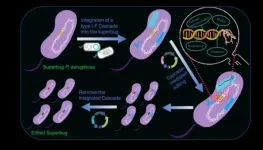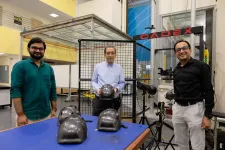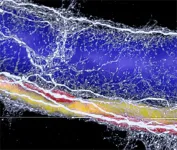Infrared held in a pincer
A NIR-II-emitting chromium complex
2021-07-22
(Press-News.org) Many applications, from fiber-optic telecommunications to biomedical imaging processes require substances that emit light in the near-infrared range (NIR). A research team in Switzerland has now developed the first chromium complex that emits light in the coveted, longer wavelength NIR-II range. In the journal Angewandte Chemie, the team has introduced the underlying concept: a drastic change in the electronic structure of the chromium caused by the specially tailored ligands that envelop it.
Many materials that emit NIR light are based on expensive or rare metal complexes. Cheaper alternatives that emit in the NIR-I range between 700 and 950 nm have been developed but NIR-II-emitting complexes of non-precious metals remain extremely rare. Luminescence in the NIR-II range (1000 to 1700 nm) is, for example, particularly advantageous for in vivo imaging because this light penetrates very far into tissues.
The luminescence of complexes is based on the excitement of electrons, through the absorption of light, for example. When the excited electron drops back down to its ground state, part of the energy is emitted as radiation. The wavelength of this radiation depends on the energetic differences between the electronic states. In complexes, these are significantly determined by the type and arrangement of the ligands bound to the metal.
In typical chemical (covalent) bonds, each partner brings one electron to share in a bonding pair; in many complexes both of the electrons come from the ligand. However, the line between these types of bonds is fluid: metal-ligand bonds can have partial covalent character (nephelauxetic effect). As a consequence, the energy of certain excited states is reduced, giving the emitted radiation a longer wavelength. This has been observed for polypyridine ligands, which cause the ruby red emission of trivalent chromium (Cr(III)) in complexes to shift into the NIR-I range.
In order to increase the covalence of the metal-ligand bond and further increase the wavelength, Narayan Sinha in a team led by Claude Piguet and Oliver S. Wenger at the Universities of Basel and Geneva (Switzerland) switched from classic polypyridine ligands to a newly tailored, charged, tridentate chelate ligand. The term chelate is derived from the Greek word for the pincer of a crab, and tridentate means that the ligand has three binding sites with which it grabs the central metal ion like a pincer.
In the resulting new complex, the Cr(III) ion is surrounded on all sides by two tridentate charged chelate ligands to form an octahedral shape. This results in a drastically altered, unusual electronic structure with a high electron density on the Cr(III). In the axial direction, charge transfer takes place from the ligands to the metal, but in the equatorial plane of the octahedron, charge transfer moves from the metal to the ligands. The combined "push" and "pull" interactions likely have a strong influence on the spectroscopically relevant electrons of the Cr(III)--the key to the NIR-II emissions of the new complex.
INFORMATION:
About the Author
Oliver S. Wenger is a Full Professor at the University of Basel (Switzerland). The main interests of his research group are photoactive metal complexes, luminescence phenomena, photocatalysis, and solar energy conversion. Narayan Sinha has been a postdoctoral researcher in his group since 2019.
https://wenger.chemie.unibas.ch/
ELSE PRESS RELEASES FROM THIS DATE:
2021-07-22
A research team led by Wim Annaert (VIB-KU Leuven) uncovered the early assembly of gamma-secretase, a protein complex linked to numerous cellular processes including the development of Alzheimer's disease. In a first step, two dimeric subcomplexes are formed, which independently exit the ER and only afterwards assemble into a four-subunit complex. This 'buckle up' mechanism is thought to prevent premature assembly and activity. The new insights are very relevant, as gamma-secretase is an important potential therapeutic target for Alzheimer's and other ...
2021-07-22
A research team led by Dr Aixin YAN, Associate Professor from the Research Division for Molecular & Cell Biology, Faculty of Science, in collaboration with Honorary Clinical Professor Patrick CY WOO from the Department of Microbiology, Li Ka Shing Faculty of Medicine, the University of Hong Kong (HKU), reported the development of a transferrable and integrative type I CRISPR-based platform that can efficiently edit the diverse clinical isolates of Pseudomonas aeruginosa, a superbug capable of infecting various tissues and organs and a major source of nosocomial infections. The ...
2021-07-22
As cities worldwide expand their networks of cycling paths and more cyclists take to the streets, the chances of cycling accidents and potential collisions increase as well, underscoring the need for proper cycling safety in dense urban areas.
According to a World Health Organisation report in 2020, more than 60 per cent of the reported bicycle-related deaths and long-term disabilities are a result of accidents with head injuries.
Researchers from Nanyang Technological University, Singapore (NTU Singapore), in collaboration with French specialty materials leader Arkema, have developed a tougher, safer bicycle helmet using a combination of materials. The new helmet prototype has higher energy absorption, reducing the amount of energy ...
2021-07-22
With the application of a novel three-dimensional imaging technology, researchers at Karolinska Institutet in Sweden have discovered that one portion of the autonomic nervous system in the liver undergoes severe degeneration in non-alcoholic fatty liver disease. The study, which is conducted in mice and human liver tissue, shows that the degeneration of nerves is correlated with the severity of liver pathology. The results are being published in the journal Science Advances.
Non-alcoholic fatty liver disease is the most common hepatic disorder, with prevalence around 25 percent globally. Approximately ...
2021-07-22
The building sector in the U.S. accounts for 39 percent of energy use, with commercial buildings responsible for about half of that. As cities grapple with climate change, making commercial buildings more efficient is a key part of the solution.
Researchers at the University of Pittsburgh Swanson School of Engineering and the Mascaro Center for Sustainable Innovation used the City of Pittsburgh to create a model built upon the design, materials and purpose of commercial buildings to estimate their energy usage and emissions. While other models may ...
2021-07-22
FRANKFURT/HANNOVER. The international team of geoscientists led by Prof. Silke Voigt from the Goethe University Frankfurt, Prof. Ireneusz Walaszczyk from the University of Warsaw and Dr André Bornemann from LBEG have thoroughly investigated 40 metres of the geological strata sequence in the former limestone quarry at Hasselberg. The researchers determined that this is only sequence in the transition between Turonian and Coniacian without gaps and it therefore represents a perfect rock sequence to serve geoscientists from all over the world as a reference for their research - a "Global Stratotype Section and Point (GSSP)" or, in the jargon of geosciences, a "golden nail".
Certain group of bivalve mollusks of the family Inoceramidae, first appeared in the Coniacian, and ...
2021-07-22
ORLANDO, July 22, 2021 - Disagreement seems to spread online posts faster and further than agreement, according to a new study from the University of Central Florida.
The finding comes from an examination of posts labeled controversial on social news aggregation site Reddit. To perform the study, the researchers analyzed more than 47,000 posts about cybersecurity in a Reddit dataset that was collected by the Computational Simulation of Online Social Behavior (SocialSim) program of the U.S. Defense Advanced Research Projects Agency.
Researchers found that these posts were seen by nearly twice the number of people and traveled nearly twice as fast when compared ...
2021-07-22
In a new study, published recently in the journal Circulation Research, scientists discover how the production of protective molecules known as specialised pro-resolving mediators (SPM) is altered in patients with COVID-19.
The results suggest that treatments which increase SPM production, such as dexamethasone or SPM based drugs, could play a key role in limiting inflammation in these patients.
Currently there is little understanding around the mechanisms that lead to uncontrolled inflammation in patients with COVID-19.
The study found a link between decreased SPM blood levels and disrupted white blood cell responses in patients with a higher disease burden. The findings also revealed that dexamethasone, the first drug ...
2021-07-22
More than 820 million people in the world don't have enough to eat, while climate change and increasing competition for land and water are further raising concerns about the future balance between food demand and supply. The results of a new IIASA-led study can be used to benchmark global food security projections and inform policy analysis and public debate on the future of food.
Despite the fact that food supply has increased dramatically since the 1960s, the question of how to eradicate global hunger - one of the Sustainable Development Goals - and feed the growing world population in years to come, remains a major challenge. Climate change and increasing competition ...
2021-07-22
Alexandria, Va., USA - Xingying Qi, West China Hospital of Stomatology, Sichuan University, Chengdu, China, presented the oral session "Cannabidiol Promotes Oral Ulcer Healing by Inactivating CMPK2-Mediated NLRP3 Inflammasome" at the virtual 99th General Session & Exhibition of the International Association for Dental Research (IADR), held in conjunction with the 50th Annual Meeting of the American Association for Dental Research (AADR) and the 45th Annual Meeting of the Canadian Association for Dental Research (CADR), on July 21-24, 2021.
The oral ulcer is a common oral inflammatory lesion with severe pain but little ...
LAST 30 PRESS RELEASES:
[Press-News.org] Infrared held in a pincer
A NIR-II-emitting chromium complex




